Things That Seem Paradoxical Can Coexist
Alex Webb interviewed by Marek Grygiel and Adam Mazur
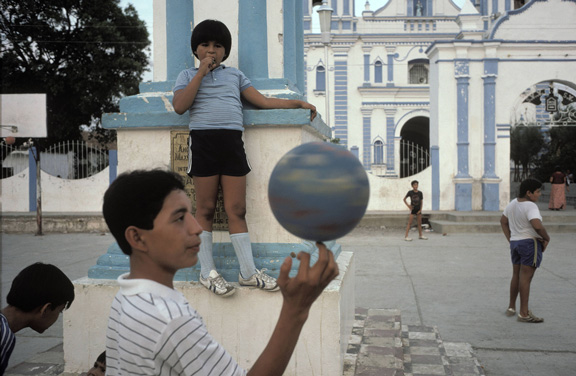
Alex Webb, 1985
MEXICO. Oaxaca State.
MEXICO. Tehuantepec. 1985, Children playing in a courtyard.
© Alex Webb / Magnum Photos
FOTOTAPETA - Critics write about your use of color, but I was thinking about your photographs from the point of view of where they were taken, about differences between the North and the South, about the clash of cultures rather than colors. In your photographs, the South is a kind of a different world. Could you describe why you have chosen to take pictures in these particular parts of the world like Mexico, Haiti, the Caribbean?
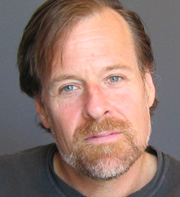
Alex Webb.
Photo Adam Mazur.
ALEX WEBB was born i San Francisco 5 of May 1952. He studied history and literature at Harvard University and began working as a professional photojournalist in 1974. He joined Magnum Photos as an associate member in 1976, becoming a full member in 1979.
Webb has photographed extensively in the United States, the Caribbeean, Latin America, Africa, and most recently in Istambul. His photographs have appeard in such publications as New York Times magazine, Life, Geo, Stern, And National Geographic. He has published five books: Hot Light/Hal-Made Worlds (1986), Under a grunding sun (1989), From the Sunshine State (1996), Amazon (1997), and Crossings (2003). He has also created a limited edition book titled Dislocations (1998-99).
Webb received a New York Foundation of Arts Grant in 1986, a National Endowment for the Arts Fellowship in 1990, and a Hasselblad Foundation Grant in 1998. He won the Leopold Godowsky Color Photography Award in 1988, the Leica Medal of Excellence in 2000, and the David Ocatavius Hill award in 2002. Museums that have exhibited his work include the Walker Art Center, the Museum of Photographis Arts, the International Center of Photography, the High Museum of Art, the Southeast Museum of Photography, the Museum of Contemporary Art San Diego, and Whitney Museum of American Art.
(na podst. Yours, Gallery Portfolio N5)
ALEX WEBB - There are different kinds of photographers, and some photographers feel the need to photograph where they live, and others go out and leave where they come from behind and explore. I think of my first explorations, and how exactly and why that did take me to the South no one knows. I did start photographing both in the American South and then the US-Mexico border and Haiti. In Haiti and the US-Mexico border I began to sense something, a sense of energy on the street, a sense of life as lived on the street. I come from New England, the northeastern part of the US, where things really happen very much behind closed doors. You do not have the sense of life out on the street. Going to the US-Mexico border or to Haiti was a sense of energy and immediacy on the street. I found it very exciting.
I started as a black-and white photographer, but then also I discovered the intensity of color in these places, and that is why I began working in color, because I found myself working in places where color played a very special role. It was very much a part of the culture. It was embedded in the culture. Those were reasons why I was drawn to those places.
I think also there have been certain motivations that have come out of literature, I think that my first trip to Haiti I made right after reading Graham Greene's "The Comedians", which is a novel set in Haiti. It really interested me and scared me about Haiti. My first book, "Hot Light/Half-Made Worlds" (1986), which is a series of photographs from the tropics, probably has a sort of complicated depth to the metaphors that exist in Conrad's "Heart of Darkness" - a journey into a kind of darkness. That first book is really structured that way, as a journey from light to dark, from things that are more elusive and fleeting to the things that are more and more intense and heavy. So it is very complicated to figure out exactly why one chooses to go wherever one chooses to go, because a lot of it has to do with intuitive choices. But I would say it is a combination of wanting to leave the world of New England and being inspired by certain books and finding things and getting more and more excited following those passions.
Today's difference between the North and the South is in many ways political and economical, but unlike e.g. Sebastiao Salgado, another great Magnum photographer, you do not seem to be interested in presenting us photographic documents of poverty and oppression.
You are right. Sebastiao has rather specific agenda, and I do not have that. But it does not mean that my photographs do not have political overtones, but the thing is I do not go and photograph, lets say in Mexico and Haiti, because of the political or economic tensions between the North and the South. I am intrigued by the totality of the cultures of these places. I am excited by them and moved by them. But setting divisions between the US and Mexico, on the one hand there is economic division, but there are so many other divisions. The US is a country where at least its roots lie in a sort of protestant capitalist tradition, a work ethic in Max Weber's sense of protestant ethic and sense of work. Whereas Mexico really comes out of Catholic and indigenous view of the world. There is a different sense of a community in Mexico. There is a communal sense to villages that does not exist in the United States. That is another of the big differences. Certainly, another one is the sense of color. You walk into a Mexican village and it is a whole different thing from protestant America. So I am looking at all those kinds of divisions. But if you think of someone like Salgado having a predominantly socio-political impulse, I think my first impulse is actually an esthetic one. But then it is also a political one, and an economical one, and a sociological one and so forth, but I do think that I do respond to the world of form and color...
Interestingly, Salgado shows this "other" world in black and white, while you use color as a means of grasping the sociological, cultural and religious character of Southern cultures. But at the very beginning you used B&W photography. What was the reason that you started to use color? Was it somehow connected with the fact that B&W was a part of the street photography tradition and choosing color meant choosing a new kind of photojournalism?
I do not know whether it is a new kind of photojournalism, or whether my roots lie in street photography, but I am interested in places where there is a certain level of political and cultural tension. In other words, I think that I work very much like a street photographer: I just wander around. My spirit of working is really wandering and letting my experiences on the street and the camera lead me where they will. But the places that I go to - Haiti, the Mexico border - are places where there are obvious political and cultural tensions going on, so those are also expressed in my photographs. And that is something that is not necessarily associated with "street photography". When we think of the tradition of street photography, we think of Cartier Bresson, Kertesz. If you look at someone like Robert Frank - I mean Frank certainly has a high political component, certainly to "The Americans" - maybe less to his other works. It is sometimes also in street photography as well. But in terms of the shift to color, I really think it had to do with the fact that I found myself working in places where color seemed to be very, very important to my experience of that culture. You go to Mexico and you walk down the street and you are assaulted by the colors. It is an explosion that takes place. And you feel that it is in the heart of that culture. Of course, if you go to New York now, it is full of color. Times Square is full of color, but it is really full of color to sell things. It is commercial color. And it is designed very specifically to sell things. I am sure it is true to say that in Mexico color is used to sell things too, but somehow you feel that the color is more embedded in the heart of the society in Mexico or the Carribean.
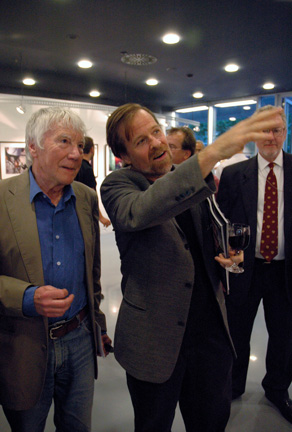
Alex Webb in conversation with Polish photographer, Tadeusz Rolke (left), YOURS Gallery, Warsaw, Poland. Photo: Andrzej Bogacz.
You were born in San Francisco and then you moved to New England?
Yes, I was born in San Francisco, but I only lived there for six months. My parents are from the East. They were in San Francisco because in the late 40s and early 50s there was a sort of literary scene in San Francisco, with Dylan Thomas and so forth. My parents were there because they wanted to follow this literary scene. Then they moved back to the East Coast. Initially to New York and Connecticut, and eventually Massachusetts. So I am really from New England.
I am asking about this because I find those relations between California and Mexico, or more generally between Mexico and the South of the US, interesting. There is quite an intense exchange between photographic milieus going on. A good example of that is Fotofest in Huston, where many Mexican photographers are often present. Recently, Flor Garduno exhibited at the CCA Ujazdowski Castle.
It is absolutely true. Actually, just one month ago Flor Garduno and I had a show in Tucson, Arizona. I know that anyone reading my biography thinks, "Oh, California! That is why he has this interest." It is not the case. We left California early, but I think in many ways my interest in Mexico and the Carribean has been a reaction against living in New England. There is a kind of gray, brown iridescence, you do not very often see the kind of immediacy and passion and intensity that one sees in Mexico for example.
What was the reason that you joined Magnum? Practical or artistic?
Well, probably some of both. I actually came into contact with Magnum after a workshop that I took with Bruce Davidson. Actually, Bruce left after two days. He had another commitment. And another photographer of Magnum - Charles Harbutt - took over. At that time Charles was very, very attuned to teaching and I got really close to Charles. You may not know his work. He is not nearly as well known as some other photographers. He did a book called "Travelog". And there is a wonderful essay about photography. It is one of the best essays about this kind of photography that has ever been written. He talks about what makes this kind of photography special. Anyway, I got along very well with Charles. And Charles was the person who suggested that I apply to Magnum. He suggested it to me when I was at the end of the college. He suggested, I applied, and to my great surprise I was accepted. I think it was a time when not as many photographers were applying as now, what makes it hard to get in. But I was pretty serious about photography in college. By the end of college I worked on two serious projects, both of which did get published. I have to say that I did not really think of that much about it except that I came out of college and I knew that I wanted to do certain kind of photography, but I did not know how I was going to make a living, had not really thought about being a professional photographer, could not know what that involved, but also had alternatives which seemed to be going back to graduate school to get a teaching degree. I did not really like the idea of sitting at the university and teaching, what I wanted to be was to be a photographer.
While living in Boston did you by chance get to know people from the so-called Boston School? Nan Goldin or Lorca di Corcia?
Not really. Lorca di Corcia is younger than I am. Nan is almost the same age as me, but I did not actually know Nan. She went to the museum school. I did not know her. There was a lot of photography in Boston at that time. There was a photographer, Jonathan Green, who ran the MIT gallery, so I was in touch with him. I think he is now the director of the California Museum of Photography in Riverside. But I did not have contact with Nan, and I did not shoot color then at all either. When I was in college, everything was black and white. What happened, was that after I left college, I moved to New York and then I just become a school nominee with Magnum. I think that one thing coming into contact with Magnum did was that it opened up possibilities in terms of other places to photograph. Because when I started out, when I was in college, I photographed in the Boston area, I photographed in Vermont and had photographed a little bit in Europe. But I did not really have a sense of photographing out there, beyond that, in the world. I also think there was not quite the same ease with which people just rushed off in different directions. I mean young photographers more immediately getting on planes and willing to go here and there. It was a sort of start to go off towards something. So I took this trip to Haiti, and I took this trip to the Mexico border, and in both those places I sensed some things that I never experienced before as a human being or as a photographer, and it really changed my life. And then as I worked there more and started photographing in color, it changed my life even more.
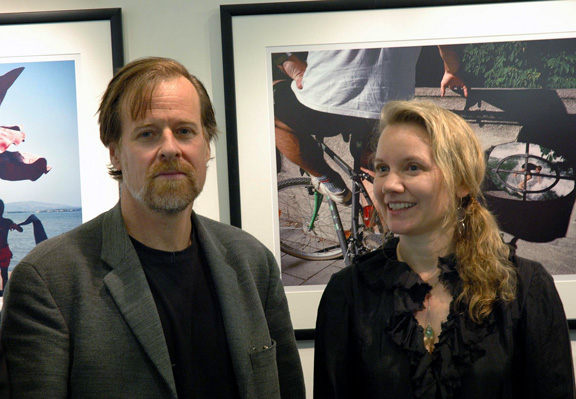
Alex Webb and Rebecca Norris Webb at YOURS Gallery, Warsaw, Poland. Photo by Andrzej Bogacz.
Magnum people must have been surprised with you switching immediately from black and white to color photography?
I don't know. Sure. I always felt to some extent that I am out one fringe of Magnum, but I was brought into Magnum particularly by Charles Harbutt, and Charles was really oriented not towards traditional photojournalism at that point. I mean at that point Marc Riboud was doing a lot of rather traditional photojournalism. Charles was encouraging a much more personal kind of vision of the world, and that influenced me much more. I have taken elements of that, which is a very personal approach, but taken them into situations that people do not associate with a totally personal approach like going somewhere else, like Haiti, where political violence takes place, therefore it is photojournalism, but I am actually taking a very personal approach inside places like Haiti.
Do you think that in the 70s, when you were joining Magnum, there was a gap between photojournalism and art photography? Now, photojournalism has entered the art world for good and you and other Magnum photographers have their pictures exhibited in art galleries, museums, rather than magazines or newspapers. The latter tend to show simple news photography.
Well, if you look at Magnum, both traditions were there from the beginning, photojournalistic and artistic. There was always Cartier-Bresson, and there was always Bob Capa. Carier-Bresson showed at the Louvre and at the Museum of Modern Art very, very early. And Capa went off to do wars. So there always has been the division in Magnum, or those two poles, and I think within Magnum that has expanded more and more as the world of photography has gotten more complex. I do think that in the late 60s and early 70s there increasingly came an interest in a more personal kind of photographic exploration within the context of photojournalism or documentary. Probably the roots for that lie in Robert Frank. You can see it in people like Lee Friedlander, Garry Winogrand, more documentary being Diane Arbus. I think that sense of what was going on there did have a big influence on a number of photographers who were exploring more politically charged situations, and years passed and color became part of the vocabulary. There was a show, for instance, done in 1986 by the Walker Art Centre in Minneapolis that traveled round the United States, called "The New Color Photojournalism". It included myself and Rio Branco, David Burnett, Michel Folco, Harry Gruyaert, Jeff Jacobson, Mary Ellen Mark, Susan Meiselas, Yan Morvan, Gilles Peress, Rio Branco, Jean-Marie Simon and Alfred Yaghobzadeh. I think that sort of shows begin to point out of new kind strength that was emerging in that world.
Will you try to develop your uses of color in different regions of the world? Ukraine, Romania are very colorful countries too.
Maybe. Istanbul has a very different color from the Caribbean for instance. There is no doubt about the fact that I emerged as a photographer in the context of these places where color is very intense, but I photographed elsewhere in color and I am intrigued by other kinds of possibilities in color. Actually, this is the second time I have been in Warsaw. I was here in 1989 in December and there was something interesting about the color, because it was so monochromatic. I have embraced this intense world of color of the tropics, but I am not against exploring other possibilities and I think Istanbul is one step in that direction. Maybe there will be some more steps. I do not know what they would be into somewhere in Eastern Europe, or whether it would be somewhere into Central Asia. I do not know, but I am interested.
What is the influence of digital technology on your photography?
What has influenced me in terms of digital technology is the technique of printing. These photographs are printed with a lambda or light-jet machine, which produces a print on photographic paper but it is written from a scan with a laser. For me what it means is that you have much, much more control over color than in the darkroom. I used to make cibachromes, and it was just a huge struggle. You had to make special masks, specifically to control reds, because reds in cibachrome go crazy. With this technique you make a really high-res scan and I work with a printer to control certain things I do with Photoshop. I make a test print and I go in and say "This needs a little more magenta, we need a little more contrast here," and so forth. Then I come back after few days and after several proof prints we have it right. For me, digital technology has utterly transformed the process of printing and it has made it much closer and much more personal in many ways, because it is much more like the way I used to work in the darkroom as a black-and-white photographer. I love that. I am really excited about prints in a way that I was not before. It is also easier to make larger prints. This show is all this size, but I also make larger prints for certain shows. For certain pictures, they really get another kind of presence as an object when you make them larger.
This exhibition includes one of your photographs of New York. Did you make more photographs in New York?
I do photograph the New York. There are some photographs. Irregularly. There are some projects. There was a period of time when I was actually photographing Coney Island in a summer a lot. And there was a period of time when I was photographing the Wall Street area a good deal. More recently I have been doing some work in the outer boroughs. People from the outside look at New York and they just think Manhattan, but I find the boroughs increasingly interesting, because the boroughs are very culturally mixed. I recently did some work in Sunset Park, Brooklyn and one part of Sunset Park is Brooklyn's Chinatown and it is not like Manhattan's Chinatown. It is totally Chinese. Next to it is Brooklyn's Mexico Town. You go to Jackson Heights in Queens and you have areas totally populated by people from India. I found those places interesting. There are some photographers who really manage to work extensively in places where they live. I find it terribly difficult on a whole bunch of different levels. I think one is simply that when the place you live is so much a place of business and you have so many contacts there, that when I come back and I just feel that I've got to call this person, got to call that person... There are so many distractions. When I go off away from New York there it is me, my camera, and the world. That is it. I do not have to think about anything else. It is maybe my own specific lack of discipline that I am not tough enough forcing myself everyday to so something in the New York. But I think also that I love New York. It is a great, great city, but I have not been emotionally inspired, moved by New York the same way as I am by the streets of Mexico. New York just does not move the same way. I can't really explain why. Maybe it is also because New York has been photographed so much. One of the first times I went to Paris as a photographer, I just looked around and I looked over there and I saw that there is Doisneau, there is Brassai, there is Kertesz, and there is Cartier-Bresson. I just thought, "What am I going to do with my camera?"
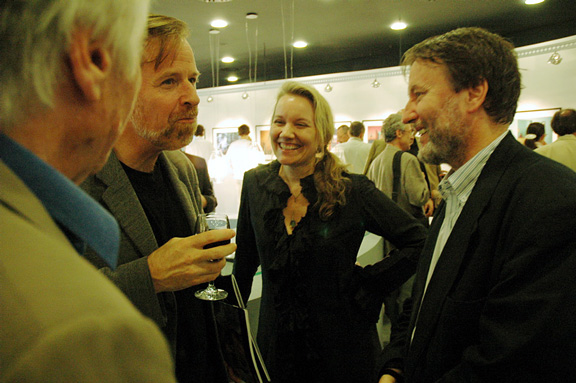
Opening party at YOURS Gallery in Warsaw. From left: Tadeusz Rolke, Alex Webb, Rebecca Norris Webb and Marek Grygiel. Photo: Andrzej Bogacz.
Working on this exhibition, you chose all the pictures yourself. Is there any key or order that we should pay special attention to?
I have never shown any pictures before in Poland, so what I decided to give is a sense of a range of my work, particularly touching more on more recent projects, but bringing in a few other things. Most of this work came from Cuba and the US-Mexico border, Istanbul and Haiti. Cuba and Istanbul are ongoing projects. The border is out as a book, but it is my most recent book. I felt that there should be two of my most famous pictures. They are from my first book and then the gallery requested that this picture be here [9/11 photograph]. I would not have normally included that, just because I feel it is another kind of thing, but still... I do not know who is on this picture. One of the things about this kind of photography is that it is very serendipitous. You do not know what you're going to find when you go out the door. When the planes hit the towers, I was not aware of what was going on. Once I realized what is going on, I grabbed my cameras. My wife, who is also a photographer, grabbed hers and we went out. The whole public transportation was shut down because of what happened to World Trade Center. So we got to a car rental place and we rented a car, because we live in Brooklyn, so we were about five miles from WTC. We drove from our part of Brooklyn to the East River across from Manhattan. We stepped out of the car and a woman came out of the building and said, "Would you like to see what it looks like from the roof?" So we went up and that is what we found. I mean, we found other people and so forth, but that was... It is some instinct. It is some chance and some luck. I think that with this kind of photography the more you are out in the world, the more possibilities there are. But the possibilities remain inexplicable till when they actually do happen.
Do you always have your camera with you?
No. I do not carry a camera very much in New York, unless I am working. I have to say that I am not very good about casually having the camera, occasionally taking pictures. When I am working, then I really have to work. I really have to work. I really have to stay attuned. I have to get up early in the morning, get out and I wonder and maybe the light is getting less interesting, then I eat my breakfast... I work in color, where light is really important in a very special way, so I work certain hours much more than others. I am always out at the latter half of the afternoon and in the evening. It is a whole sort of ritualistic process and a part of it is also that notion that if it is not working I just have to walk more. I do believe that there is something of a disciple. Disciple art of walking and wondering. It is not that you just drive along, jump out of the car and take a picture and get back to the car. It is really about walking and feeling the situation. How do you enter the situation. Some situations you get comfortable just walking right in. Others you have to sort of dance around the edge and come in here. The whole sense of the process, a rhythm of the process. The process of going back to a place. The process of learning about a place. When I am starting something or another, let us say I am going off to some country, I read some stuff about it, but I do not read too much before I go. I read enough to be able to work a little bit, but until I start actually visually experiencing the country, I do not want to read too much, because I do not want my intellectual knowledge to hinder the immediacy of my response. Once I get into something, then yes. I read a lot about history, politics of a place. Before I go, I do not want to know too much, because I might not see the things that are surprising and are different. What I want to experience is this sudden moment of visual insight.
An insider's view, rather than an outsider's. Like in the picture with the Mexicans caught by American border guards. It looks like it took place in paradise.
I think that terrible tragedies can happen in bright sunlight or beautiful light. I believe in responding in totality of the situation. I believe in a kind of very complicated response. A country like Haiti probably has the most extreme responses, because when I am working in Haiti one part of me thinks, "Oh, this is such a remarkable place, I want to work here for the rest of my life," and another part of me thinks, "This is so horrific and awful. I want to get on the plane and leave immediately." You have those sensations at the same time. I like the notion that things that seem paradoxical can coexist. That there can be the tragedy of the Mexicans arrested, but they are in the sea of beautiful flowers in the late afternoon light and so forth. I would like to try to embrace those kinds of paradoxes.
(Edited by Adam Mazur; proofreading: Simon Cygielski)
See also:
Copyright © 1997-2025 Marek Grygiel / Copyright for www edition © 1997-2025 Zeta-Media Inc.